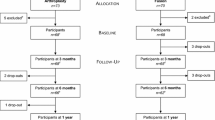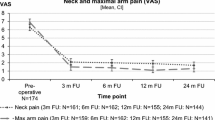Abstract
The purpose of the present study was to investigate the influence of the evaluation technique on the outcome of the Cloward procedure in cervical radiculopathy. The retrospective study included 94 consecutive patients operated on with anterior decompression and fusion with heterologous bone (Surgibone, Unilab). There were 56 men and 38 women, with a mean age of 48 years (range 27–78 years). Sixty-six patients had a single-level fusion, 26 a two-level fusion and one patient had a three-level fusion. The follow-up rate was 91/94 (97%) and evaluation was performed by an independent observer. Pain was quantified by visual analogue scale (VAS, range 0–100), functional disability by the new functional index Cervical Spine Functional Score (CSFS, range 0–100) and by the Neck Pain Disability Index (NPDI, range 0–100). The overall clinical outcome was assessed as excellent, good, fair or poor by both the patient and by the independent observer using Odom's criteria. At a mean follow-up of 26 months (range 12–56 months) the mean pain index was 39 (range 0–98), the mean CSFS 39 (range 0–85) and the mean NPDI 32 (range 0–76). The classification of the observer was 37% excellent, 40% good, 17% fair and 6% poor, and that of the patient was 53% excellent, 23% good, 20% fair and 4% poor. In the group classified as good by the observer, all scores were above 40, suggesting considerable remaining symptoms, and only 50% had returned to work. The results suggest that previous reports on the Cloward procedure using categorizations into excellent, good, fair or poor have overestimated the efficacy of the procedure. Only an excellent, but not a good, result as classified by the patient or an independent observer reflects a successful outcome. Neither of the variables studied seems independently sufficient for a balanced reflection of the outcome. The results suggest pain (VAS) as the primary outcome measurement, which, combined with the overall evaluation by the independent observer and work status, gives a multidimensional expression of the outcome.
Similar content being viewed by others
Author information
Authors and Affiliations
Additional information
Electronic Publication
Rights and permissions
About this article
Cite this article
Javid, D., Hedlund, R., Vavruch, L. et al. Is the efficacy of the Cloward procedure overestimated? Technique of evaluation affects the outcome. Eur Spine J 10, 222–227 (2001). https://doi.org/10.1007/s005860100261
Received:
Revised:
Accepted:
Published:
Issue Date:
DOI: https://doi.org/10.1007/s005860100261




